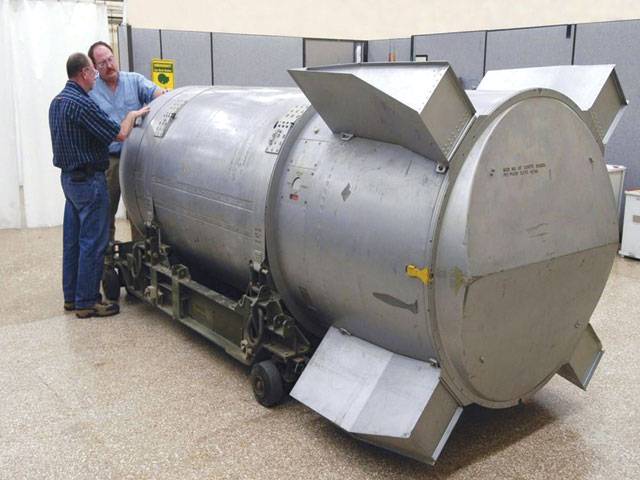WASHINGTON: The US nuclear arsenal needs a multi-billion dollar overhaul in the coming decade to ensure the weapons’ safety and effectiveness, defense officials said on Tuesday, despite warnings from arms control groups that the effort is unaffordable and unnecessary.
Assistant Defense Secretary Madelyn Creedon told a panel in the US House of Representatives that modernization work on the aging weapons was needed to give policymakers the confidence they need to pursue President Barack Obama’s goal of deeper cuts to the nuclear stockpile. “Modernization work of this kind is expensive, but there is no doubt that the investment ... is necessary,” Creedon told lawmakers examining a program to reduce the number of warhead types for US nuclear bombs and to put guidance systems on the weapons.
“There is not a cost-effective alternative that meets the military requirements and policy objectives,” she said, adding that the B61 gravity bomb, which is deployed in Europe, is a “cornerstone” of the US nuclear deterrence commitment to NATO.
The United States is currently at the start of what Air Force General Robert Kehler, the head of US Strategic Command, told the panel was a “multi-decade effort to recapitalize our nuclear deterrent force and its supporting infrastructure.”
In addition to modernizing 1970s-era weapons, in some cases replacing 1960s-model vacuum tubes with current-day electronics, the Pentagon plans to upgrade much of its so-called triad of delivery systems, including a new class of ballistic missile submarines and a new type of long-range bomber.
The non-partisan Stimson Center think-tank last year estimated the total cost of the nuclear upgrade over the next decade, including weapons, infrastructure and delivery systems, at between $350 billion and $400 billion.
The plans, which call for increased nuclear outlays, come at a time when tight budgets are forcing the Pentagon to slash projected spending by nearly $1 trillion over the next decade.
The modernization effort has drawn criticism from arms control groups. The independent Union of Concerned Scientists said in a report last week the plans were misguided and violated the spirit of Obama’s pledge not to develop new nuclear weapons.
Kingston Reif, an analyst at the Center for Arms Control and Non-Proliferation, said spending nearly $11 billion to upgrade the B61 bomb at a time when tight budgets are forcing US military cuts is also unwise.
“That program is unaffordable, unrealistic and unnecessary because there are cheaper alternatives to extend the life of the weapon,” he said in an interview.
Obama has endorsed the goal of a world without nuclear weapons and negotiated the “New START” treaty with Russia, which committed the former Cold War rivals to reducing deployed strategic nuclear weapons to 1,550 each by 2018.
The US leader said in a speech in Berlin this summer he had concluded he could further cut deployed US strategic weapons by a third, to between 1,000 and 1,100, and still guarantee US and allied security.
Officials responsible for the US arsenal told the House panel on Tuesday that to enable deeper cuts, officials needed to have complete confidence that existing weapons would work.
“There are physical processes occurring in these weapons that ... require that we execute this life extension program,” said Dr. Paul Hommert, the director of Sandia National Laboratories, which is responsible for ensuring the arsenal is safe and reliable.
Wednesday, April 17, 2024
US N-arms overhaul needed to ensure reliability

Pride and hype as F1 roars back to China after Covid absence
10:36 PM | April 16, 2024
No let-up in Karachi street crime incidents
10:35 PM | April 16, 2024
Stock market today: Most of Wall Street weakens again as Treasury yields rise more
10:34 PM | April 16, 2024
Muslim K-popstar Daud Kim buys land to build mosque in South Korea
10:33 PM | April 16, 2024
Punjab Stadium unavailability derails National Challenge Cup 2023 Final Round
10:28 PM | April 16, 2024
Political Reconciliation
April 16, 2024
Pricing Pressures
April 16, 2024
Western Hypocrisy
April 16, 2024
Policing Reforms
April 15, 2024
Storm Safety
April 15, 2024
Democratic harmony
April 16, 2024
Digital dilemma
April 16, 2024
Classroom crisis
April 16, 2024
Bridging gaps
April 16, 2024
Suicide awareness
April 15, 2024
ePaper - Nawaiwaqt
Advertisement
Nawaiwaqt Group | Copyright © 2024





